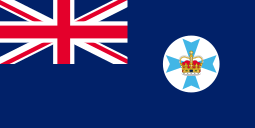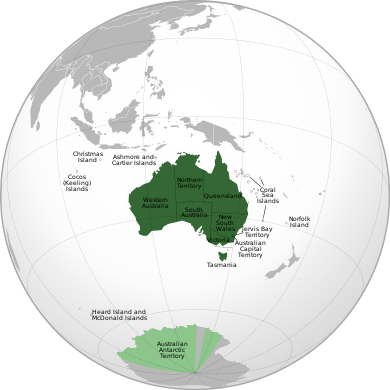Queensland
Queensland (locally /ˈkwiːnzlænd/ KWEENZ-land,[note 1] abbreviated as Qld, officially the State of Queensland) is a state of Australia. It is the second-largest and third-most populous Australian state. It is a federated state and a parliamentary constitutional monarchy. Situated in the north-east of the country, it is bordered by the Northern Territory, South Australia and New South Wales to the west, south-west and south respectively. To the east, Queensland is bordered by the Coral Sea and Pacific Ocean. To its north is the Torres Strait, separating the Australian mainland from Papua New Guinea. With an area of 1,852,642 square kilometres (715,309 sq mi), Queensland is the world's sixth-largest sub-national entity, and is larger than all but 15 countries. Due to its size, Queensland's geographical features and climates are diverse, including tropical rainforests, rivers, coral reefs, mountain ranges and sandy beaches in its tropical and sub-tropical coastal regions, as well as deserts and savanna in the semi-arid and desert climactic regions of its interior.
| Queensland | |||||
|---|---|---|---|---|---|
| |||||
| Slogan or nickname | Sunshine State | ||||
| Motto(s) | Audax at Fidelis (Bold but Faithful) | ||||
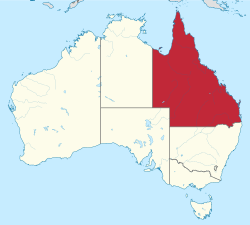 Location relative to other Australian states and territories | |||||
| Coordinates | 23°S 143°E | ||||
| Capital city | Brisbane | ||||
| Demonym | Queenslander | ||||
| Government | Constitutional monarchy | ||||
| • Governor | Paul de Jersey | ||||
| • Premier | Annastacia Palaszczuk (ALP) | ||||
| Australian state | |||||
| • Crown colony | 6 June 1859 | ||||
| • Federated state | 1 January 1901 | ||||
| Area | |||||
| • Total | 1,727,000 km² (2nd) 666,798 sq mi | ||||
| • Land | 1,730,620 km² 668,196 sq mi | ||||
| • Water | 121,991 km² (6.58%) 47,101 sq mi | ||||
| Population (December 2019)[1] | |||||
| • Population | 5,129,996 (3rd) | ||||
| • Density | 2.96/km² (5th) 7.7 /sq mi | ||||
| Elevation | |||||
| • Highest point | Mount Bartle Frere 1,622 m (5,322 ft) | ||||
| Gross state product (2018–19) | |||||
| • Product ($m) | $357,044[2] (3rd) | ||||
| • Product per capita | $70,662 (5th) | ||||
| Time zone(s) | UTC+10 (AEST) | ||||
| Federal representation | |||||
| • House seats | 30/151 | ||||
| • Senate seats | 12/76 | ||||
| Abbreviations | |||||
| • Postal | QLD | ||||
| • ISO 3166-2 | AU-QLD | ||||
| Emblems | |||||
| • Floral | Cooktown orchid (Dendrobium phalaenopsis)[3] | ||||
| • Animal | Koala (Phascolarctos cinereus) | ||||
| • Bird | Brolga (Grus rubicunda) | ||||
| • Fish | Barrier Reef anemonefish (Amphiprion akindynos) | ||||
| • Mineral or gemstone | Sapphire | ||||
| • Colours | Maroon | ||||
| Website | www | ||||
Queensland has a population of over 5.1 million,[5] concentrated along the coast and particularly in South East Queensland. The capital and largest city in the state is Brisbane, Australia's third-largest city. Ten of Australia's thirty largest cities are located in Queensland, with the largest outside Brisbane being the Gold Coast, the Sunshine Coast, Townsville, Cairns and Toowoomba. The state's population is multicultural, with 28.9% of inhabitants being immigrants.[6][7]
Queensland was first inhabited by Aboriginal Australians and Torres Strait Islanders.[8][9] Dutch navigator Willem Janszoon, the first European to land in Australia, explored the west coast of the Cape York Peninsula in 1606. In 1770, James Cook claimed the east coast of Australia for the Kingdom of Great Britain. In 1788, Arthur Phillip founded the colony of New South Wales, which included all of what is now Queensland. Queensland was explored in subsequent decades, and the Moreton Bay Penal Settlement was established at Brisbane in 1824 by John Oxley. Queensland was separated from New South Wales on 6 June 1859 (now commemorated as Queensland Day), thereby establishing Queensland as a self-governing Crown colony with responsible government, named in honour of Queen Victoria.[10] Queensland was among the six colonies which became the founding states of Australia with Federation on 1 January 1901. Since the Bjelke-Petersen era of the late 20th century, Queensland has received a high level of internal migration from the other states and territories of Australia and remains a popular destination for interstate migration.
Queensland has the third-largest economy among Australian states, with strengths in mining, agriculture, transportation, international education, insurance and banking. Nicknamed the Sunshine State for its tropical and sub-tropical climates, Great Barrier Reef and numerous beaches, tourism is also important to the state's economy.
History
The history of Queensland spans thousands of years, encompassing both a lengthy indigenous presence, as well as the eventful times of post-European settlement. The north-eastern Australian region was explored by Dutch, Spanish and French navigators before being encountered by Lieutenant James Cook in 1770. The state has witnessed frontier warfare between European settlers and Indigenous inhabitants (which did not result in any settlement or treaty), as well as the exploitation of cheap Kanaka labour sourced from the South Pacific through a form of forced recruitment known at the time as "blackbirding". The Australian Labor Party has its origin as a formal organisation in Queensland and the town of Barcaldine is the symbolic birthplace of the party.[11] A rare record of early settler life in north Queensland can be seen in a set of ten photographic glass plates taken in the 1860s by Richard Daintree, in the collection of the National Museum of Australia.[12]
Indigenous history
The Aboriginal occupation of Queensland is thought to predate 50,000 BC, likely via boat or land bridge across Torres Strait, and became divided into over 90 different language groups.
During the last ice age Queensland's landscape became more arid and largely desolate, making food and other supplies scarce. This led to the world's first seed-grinding technology. Warming again made the land hospitable, which brought high rainfall along the eastern coast, stimulating the growth of the state's tropical rainforests.[13]
European colonisation
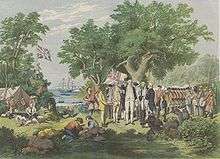
In February 1606, Dutch navigator Willem Janszoon landed near the site of what is now Weipa, on the western shore of Cape York. This was the first recorded landing of a European in Australia, and it also marked the first reported contact between European and Aboriginal Australian people.[13] The region was also explored by French and Spanish explorers (commanded by Louis Antoine de Bougainville and Luís Vaez de Torres, respectively) prior to the arrival of Lieutenant James Cook in 1770. Cook claimed the east coast under instruction from King George III of the Kingdom of Great Britain on 22 August 1770 at Possession Island, naming Eastern Australia, including Queensland, 'New South Wales'.[14]
The Aboriginal population declined significantly after a smallpox epidemic during the late 18th century.[15] There has been controversy regarding the origins of smallpox in Australia; while many sources have claimed that it originated with European colonisation, this theory has been contradicted by scientific evidence.[16][17][18] There is circumstantial evidence that Macassan mariners visiting Arnhem Land introduced smallpox to Australia.[17] )
In 1823, John Oxley, a British explorer, sailed north from what is now Sydney to scout possible penal colony sites in Gladstone (then Port Curtis) and Moreton Bay. At Moreton Bay, he found the Brisbane River. He returned in 1824 and established a penal settlement at what is now Redcliffe. The settlement, initially known as Edenglassie, was then transferred to the current location of the Brisbane city centre. Edmund Lockyer discovered outcrops of coal along the banks of the upper Brisbane River in 1825.[19] In 1839 transportation of convicts was ceased, culminating in the closure of the Brisbane penal settlement. In 1842 free settlement, which had already commenced, was officially permitted. In 1847, the Port of Maryborough was opened as a wool port. While most early immigrants came from New South Wales, the first free immigrant ship to arrive in Moreton Bay from Europe was the Artemisia, in 1848. In 1857, Queensland's first lighthouse was built at Cape Moreton.
Frontier War
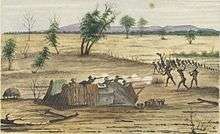
A war, sometimes called a "war of extermination",[20] erupted between Aborigines and settlers in colonial Queensland. The Frontier War was notable for being the most bloody in Australia, perhaps due to Queensland's larger pre-contact indigenous population when compared to the other Australian colonies. About 1,500 European settlers and their allies (consisting of Chinese, Aboriginal and Melanesian assistants), were killed in frontier skirmishes during the nineteenth century. Casualties among the Aboriginal people may have exceeded 30,000. The "Native Police Force", employed by the Queensland government, was key in the oppression of the indigenous people.[21]
On 27 October 1857, Aboriginals retaliating against being poisoned and raped by members of the Fraser family, attacked the Hornet Bank pastoral station on the Dawson River killing eleven people. This was one of the largest massacres of British colonists by Indigenous Australians.[22][23][24][25] The largest reported massacre of colonists by Aboriginals was in 1861 on the Nogoa River where 19 people were killed.[26] One author[27] estimates 24,000 Aboriginal men, women and children died at the hands of the Native Police in colonial Queensland between 1859 and 1897 alone.
Separation from New South Wales
A public meeting was held in 1851 to consider the proposed separation of Queensland from New South Wales. On 6 June 1859, Queen Victoria signed Letters Patent to form the separate colony of Queensland as a self-governing Crown colony with responsible government. Brisbane was selected as the capital city. On 10 December 1859, a proclamation was read by George Bowen, the first Governor of Queensland, formally establishing Queensland as a separate colony from New South Wales.[28] On 22 May 1860 the first Queensland election was held and Robert Herbert, Bowen's private secretary, was appointed as the first Premier of Queensland.
Late 19th century and Federation
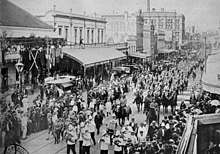
In 1865, the first rail line in the state opened between Ipswich and Grandchester. Queensland's economy expanded rapidly in 1867 after James Nash discovered gold on the Mary River near the town of Gympie, sparking a gold rush. While still significant, they were on a much smaller scale than the gold rushes of Victoria and New South Wales.
Immigration to Australia and Queensland in particular began in the 1850s to support the state economy. During the period from the 1860s until the early 20th century, many labourers, known at the time as Kanakas, were brought to Queensland from neighbouring Pacific Island nations to work in the state's sugar cane fields. Some of these people had been kidnapped under a process known as blackbirding or press ganging, and their employment conditions constituted an allegedly-explotative form of indentured labour. Italian immigrants entered the sugar cane industry from the 1890s.[29]
During the 1890s, the six Australian colonies, including Queensland, held a series of referendums which culminate in the Federation of Australia on 1 January 1901. During this time, Queensland had a population of half a million people. Since that time Queensland has remained a federated state within Australia.
20th century
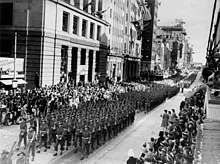
Following Federation in 1901, the White Australia policy came into effect, which saw all foreign workers in Australia deported under the Pacific Island Labourers Act of 1901, which saw the Pacific Islander population of the state decrease rapidly.[30]
In 1905, women voted in state elections for the first time, and the University of Queensland was established in 1909. In 1911, The first alternative treatments for polio were pioneered in Queensland and remain in use across the world today.
World War I had a major impact on Queensland. Over 58,000 Queenslanders fought in World War I and over 10,000 of them died.[31]
Australia's first major airline, Qantas (originally standing for "Queensland and Northern Territory Aerial Services"), was founded in Winton in 1920 to serve outback Queensland.
In 1922, Queensland abolished the Queensland Legislative Council, becoming the only Australian state with a unicameral parliament.
In 1935, cane toads were deliberately introduced to Queensland from Hawaii in an unsuccessful attempt to reduce the number of French's cane and greyback cane beetles that were destroying the roots of sugar cane plants, which are integral to Queensland's economy, and have remained an environmental pest since that time. In 1962, the first commercial production of oil in Queensland and Australia began at Moonie.
During World War II, Brisbane became central to the Allied campaign when the AMP Building (now called MacArthur Central) was used as the South West Pacific headquarters for General Douglas MacArthur, chief of the Allied Pacific forces, until his headquarters were moved to Hollandia in August 1944.[32] In 1942, during the war, Brisbane was the site of a violent clash between visiting US military personnel and Australian servicemen and civilians, which resulted in one death and hundreds of injuries. This incident became known colloquially as the Battle of Brisbane.[33]
The end of World War II saw a wave of immigration from across Europe, with many more immigrants coming from southern and eastern Europe than in previous decades.
In the latter decades of the 20th century, the humid subtropical climate—regulated by the availability of air conditioning—saw Queensland become a popular destination for migrants from interstate.[34] Since that time, Queensland has continuously seen high levels of migration from the other states and territories of Australia.
The final end of the White Australia policy in 1973 saw the beginning of a wave of immigration from around the world, and most prominently from Asia, which continues to the present.
21st century
After three decades of record population growth, Queensland was impacted by major floods between late 2010 and early 2011, causing extensive damage and disruption across the state.[35][36]
In 2020, Queensland was impacted by the COVID-19 pandemic. Despite a low number and abrupt decline in cases from April 2020 onward, social distancing requirements were implemented from March 2020 including the closure of the state borders.
Geography and environment
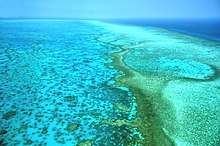
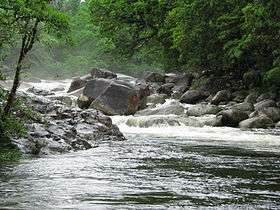
.jpg)
With a total area of 1,852,642 square kilometres (715,309 square miles), Queensland is an expansive state with a highly diverse range of climates and geographical features. If Queensland were an independent nation, it would be the world's 16th largest, being approximately the same size as Mexico, Indonesia and Mongolia.
Queensland's eastern coastline borders the Coral Sea, an arm of the Pacific Ocean. The state is bordered by the Torres Strait to the north, with Boigu Island off the coast of New Guinea representing the northern extreme of its territory. The triangular Cape York Peninsula, which points toward New Guinea, is the northernmost part of the state's mainland. West of the peninsula's tip, northern Queensland is bordered by the Gulf of Carpentaria. To the west, Queensland is bordered by the Northern Territory, at the 138th meridian east, and to the southwest by northeastern South Australia. The state's southern border with New South Wales is constituted in the east by the watershed from Point Danger to the Dumaresq River, and the Dumaresq, Macintyre and Barwon rivers. The west of the southern border is defined by the 29th parallel south (including some minor historical encroachments), until it reaches South Australia.
Like much of eastern Australia, the Great Dividing Range runs roughly parallel with, and inland from, the coast, and areas west of the range are more arid than the humid coastal regions. The Great Barrier Reef, which is the world's largest coral reef system, runs parallel to the state's Coral Sea coast between the Torres Strait and Fraser Island. Queensland's coastline includes the world's three largest sand islands: Fraser, Moreton and North Stradbroke.
The state contains six World Heritage-listed preservation areas: the Great Barrier Reef along the Coral Sea coast, Fraser Island on the Wide Bay–Burnett regions's coastline, the wet tropics in Far North Queensland including the Daintree Rainforest, Lamington National Park in South East Queensland, the Riversleigh fossil sites in North West Queensland, and the Gondwana Rainforests in South East Queensland.
Regions
The state is divided into several unofficial regions which are commonly used to refer to large areas of the state's vast geography. These include:
- South East Queensland in the state's coastal extreme south-eastern corner, an urban region which includes the state's three largest cities: capital city Brisbane and popular coastal tourist destinations the Gold Coast and Sunshine Coast. In some definitions, it also includes the city of Toowoomba. South East Queensland accounts for more than 70% of the state's population.
- The Darling Downs in the state's inland south-east, which consists of fertile agricultural (particularly cattle grazing) land and in some definitions includes the city of Toowoomba. The region also includes the mountainous Granite Belt, the state's coldest region which occasionally experiences snow.
- Wide Bay–Burnett in the state's coastal south-east, to the north of the South East Queensland region. It is rich in sugar cane farms and includes the cities of Bundaberg, Hervey Bay as well as Fraser Island, the world's largest sand island.
- Central Queensland on the state's central coastline, which is dominated by cattle farmland and coal mining. It contains the Capricorn Coast and Whitsunday Islands tourist regions, as well as the cities of Rockhampton and Mackay.
- North Queensland on the state's northern coastline, which is dominated by cattle farmland and mining and which includes the city of Townsville.
- Far North Queensland on the state's extreme northern coastline along the Cape York Peninsula, which includes tropical rainforest, the state's highest mountain, Mount Bartle Frere, the Atherton Tablelands pastoral region (dominated by sugar cane and tropical fruits), the most visited section of the Great Barrier Reef, as well as the city of Cairns.
- South West Queensland in the state's inland south-west, which is a primarily agricultural region dominated by cattle farmland, and which includes the Channel Country region of intertwining rivulets.
- Central West Queensland in the state's inland central-west, dominated by cattle farmland and which includes the city of Longreach.
- The Gulf Country (also known as North West Queensland), in the state's inland north-west along the Gulf of Carpentaria, which is dominated by savanna and mining and includes the city of Mount Isa.
Climate

Because of its size, there is significant variation in climate across the state. There is ample rainfall along the coastline, with a monsoonal wet season in the tropical north, and humid sub-tropical conditions along the southern coastline. Low rainfall and hot humid summers are typical for the inland and west. Elevated areas in the south-eastern inland can experience temperatures well below freezing in mid-winter providing frost and, rarely, snowfall. The climate of the coastal regions is influenced by warm ocean waters, keeping the region free from extremes of temperature and providing moisture for rainfall.[37]
There are six predominant climatic zones in Queensland,[38] based on temperature and humidity:
- Hot humid summer, warm humid winter (far north and coastal): Cairns, Innisfail
- Hot humid summer, warm dry winter (north and coastal): Townsville, Mackay
- Hot humid summer, mild dry winter (coastal elevated areas and coastal south-east): Brisbane, Bundaberg, Rockhampton
- Hot dry summer, mild dry winter (central inland and north-west): Mt Isa, Emerald, Longreach
- Hot dry summer, cool dry winter (southern inland): Roma, Charleville, Goondiwindi
- Warm humid summer, cold dry winter (elevated south-eastern areas): Toowoomba, Warwick, Stanthorpe
The annual mean climactic statistics[39] for selected Queensland cities are shown below:
| City | Min. temp | Max. temp | No. clear days | Rainfall |
|---|---|---|---|---|
| Brisbane | 15.7 °C (60.3 °F) | 25.5 °C (77.9 °F) | 113.1 | 1,149.1 mm (45.24 in)[40] |
| Mackay | 19.0 °C (66.2 °F) | 26.4 °C (79.5 °F) | 123.0 | 1,570.7 mm (61.84 in)[41] |
| Cairns | 21.0 °C (69.8 °F) | 29.2 °C (84.6 °F) | 89.7 | 1,982.2 mm (78.04 in)[42] |
| Townsville | 19.8 °C (67.6 °F) | 28.9 °C (84.0 °F) | 120.9 | 1,136.7 mm (44.75 in)[43] |
The coastal far north of the state is the wettest region in Australia, with Mount Bellenden Ker, south of Cairns, holding many Australian rainfall records with its annual average rainfall of over 8 metres.[44] Snow is rare in Queensland, although it does fall with some regularity along the far southern border with New South Wales, predominantly in the Stanthorpe district although on rare occasions further north and west. The most northerly snow ever recorded in Australia occurred near Mackay; however, this was exceptional.[45]
Natural disasters are often a threat in Queensland: severe tropical cyclones can impact the central and northern coastlines and cause severe damage,[46] with recent examples including Larry, Yasi, Ita and Debbie. Flooding from rain-bearing systems can also be severe and can occur anywhere in Queensland. One of the deadliest and most damaging floods in the history of the state occurred in early 2011.[47] Severe springtime thunderstorms generally affect the south-east and inland of the state and can bring damaging winds, torrential rain, large hail and even tornadoes.[48] The strongest tornado ever recorded in Australia occurred in Queensland near Bundaberg.[49] Droughts and bushfires can also occur; however, the latter are generally less severe than those that occur in southern states.
The highest official maximum temperature recorded in the state was 49.5 °C (121.1 °F) at Birdsville Police Station on 24 December 1972,[50] although the Moderate-Resolution Imaging Spectroradiometer (MODIS) on NASA's Aqua satellite measured a ground surface temperature of 69.3 °C (156.7 °F). Queensland has the highest average maximums of any Australian state, and Stanthorpe, Hervey Bay, Mackay, Atherton, Weipa and Thursday Island are the only large population centres not to have recorded a temperature above 40 °C (104 °F). The lowest recorded minimum temperature is −10.6 °C (12.9 °F) at Stanthorpe on 23 June 1961 and at The Hermitage (near Warwick) on 12 July 1965.[51] Temperatures below 0 °C (32 °F) are, however, generally uncommon over the majority of populated Queensland.
| Climate data for Queensland | |||||||||||||
|---|---|---|---|---|---|---|---|---|---|---|---|---|---|
| Month | Jan | Feb | Mar | Apr | May | Jun | Jul | Aug | Sep | Oct | Nov | Dec | Year |
| Record high °C (°F) | 49.0 (120.2) |
47.2 (117.0) |
46.7 (116.1) |
41.7 (107.1) |
39.3 (102.7) |
36.0 (96.8) |
36.1 (97.0) |
38.5 (101.3) |
42.4 (108.3) |
45.1 (113.2) |
48.7 (119.7) |
49.5 (121.1) |
49.5 (121.1) |
| Record low °C (°F) | 5.4 (41.7) |
3.3 (37.9) |
−0.2 (31.6) |
−3.5 (25.7) |
−6.8 (19.8) |
−10.6 (12.9) |
−10.6 (12.9) |
−9.4 (15.1) |
−5.6 (21.9) |
−3.6 (25.5) |
0.0 (32.0) |
0.0 (32.0) |
−10.6 (12.9) |
| Source 1: Bureau of Meteorology[52] | |||||||||||||
| Source 2: Bureau of Meteorology[53] | |||||||||||||
Demographics
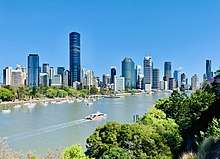

| Historical populations | ||||||||||||||||||||||||||||||||||||||||||||||||||||||||||||||||||
|---|---|---|---|---|---|---|---|---|---|---|---|---|---|---|---|---|---|---|---|---|---|---|---|---|---|---|---|---|---|---|---|---|---|---|---|---|---|---|---|---|---|---|---|---|---|---|---|---|---|---|---|---|---|---|---|---|---|---|---|---|---|---|---|---|---|---|
| ||||||||||||||||||||||||||||||||||||||||||||||||||||||||||||||||||
In 2019, Queensland had an estimated population of 5,129,996.[1] Approximately half of the state's of the population live in Brisbane, and over 70% live in South East Queensland. Nonetheless, Queensland is the second most decentralised state in Australia after Tasmania. Since the 1980s, Queensland has consistently been the fastest-growing state in Australia, as it receives high levels of both international immigration and migration from interstate. There have however been short periods where Victoria and Western Australia have grown faster.
Cities
Ten of Australia's thirty largest cities are located in Queensland. In 2019, the largest cities in the state by population of their Greater Capital City Statistical Area or Significant Urban Area (metropolitan areas) as defined by the Australian Bureau of Statistics were:[57]
- Brisbane: 2,514,184
- Gold Coast–Tweed Heads: 693,671
- Sunshine Coast: 341,069
- Townsville: 181,668
- Cairns: 153,951
- Toowoomba: 138,223
- Mackay: 80,264
- Rockhampton: 79,081
- Bundaberg: 71,309
- Hervey Bay: 55,345
- Gladstone–Tannum Sands: 45,631
Ancestry and immigration
| Country of Birth (2016)[6][7] | |
|---|---|
| Birthplace[N 2] | Population |
| Australia | 3,343,657 |
| New Zealand | 201,206 |
| England | 180,775 |
| India | 49,145 |
| Mainland China | 47,114 |
| South Africa | 40,131 |
| Philippines | 39,661 |
| Germany | 20,387 |
| Vietnam | 19,544 |
| South Korea | 18,327 |
| United States | 17,053 |
| Papua New Guinea | 16,120 |
| Taiwan | 15,592 |
Early settlers during the 19th century were largely English, Irish, Scottish and German, while there was a wave of immigration from southern and eastern Europe (most notably Italy) in the decades following the second world war. In the 21st century, Asia (most notably China and India) has been the primary source of immigration.
At the 2016 census, the most commonly nominated ancestries were:[N 3][6][7]
- English (41.3%)
- Australian (37.9%)[N 4]
- Irish (13%)
- Scottish (11.2%)
- German (6.8%)
- Indigenous (4%)[N 5]
- Chinese (3.1%)
- Italian (3%)
- Indian (1.7%)
- Dutch (1.6%)
- New Zealander (1.6%)
- Maori (1.2%)
- Filipino (1.2%)
The 2016 census showed that 28.9% of Queensland's inhabitants were born overseas. Only 54.8% of inhabitants had both parents born in Australia, with the next most common birthplaces being New Zealand, England, India, Mainland China and South Africa.[6][7] Brisbane has the 26th largest immigrant population among world metropolitan areas.
4% of the population, or 186,482 people, identified as Indigenous Australians (Aboriginal Australians and Torres Strait Islanders) in 2016.[N 6][6][7]
Language
At the 2016 census, 81.2% of inhabitants spoke only English at home, with the next most common languages being Mandarin (1.5%), Vietnamese (0.6%), Cantonese (0.5%), Spanish (0.4%) and Italian (0.4%).[6][7]
Religion
At the 2016 census, the most commonly cited religious affiliations were 'No religion' (29.2%), Catholicism (21.7%) and Anglicanism (15.3%).[59]
Economy
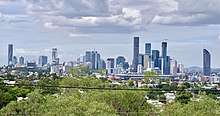
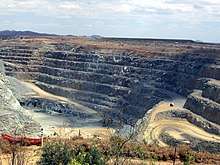
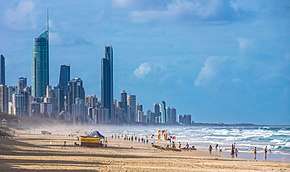
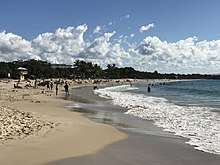
In 2019, Queensland had a gross state product of A$357,044 million, the third-highest in the nation after New South Wales and Victoria.[60] The construction of sea ports and railways along Queensland's coast in the 19th century set up the foundations for the state's export-oriented mining and agricultural sectors. Since the 1980s, a sizeable influx of interstate and overseas migrants, large amounts of federal government investment, increased mining of vast mineral deposits and an expanding aerospace sector have contributed to the state's economic growth.[61]
Primary industries include: bananas, pineapples, peanuts, a wide variety of other tropical and temperate fruit and vegetables, grain crops, wineries, cattle raising, cotton, sugarcane, wool and a mining industry including bauxite, coal, silver, lead, zinc, gold and copper.
Secondary industries are mostly further processing of the above-mentioned primary produce. For example, bauxite is shipped by sea from Weipa and converted to alumina at Gladstone.[62] There is also copper refining and the refining of sugar cane to sugar at a number of mills along the eastern coastline.
Major tertiary industries are retail, tourism and international education. In 2018, there were 134,312 international students enrolled in the state, largely focused on Brisbane. Most of the state's international students are from Asia.[63]
Brisbane is categorised as a global city, and is among Asia-Pacific cities with largest GDPs. It has strengths in mining, banking, insurance, transportation, information technology, real estate and food.[64] Some of the largest companies headquartered in Brisbane, all among Australia's largest, include Suncorp Group, Virgin Australia, Aurizon, Bank of Queensland, Flight Centre, CUA, Sunsuper, QSuper, Domino's Pizza Enterprises, Star Entertainment Group, ALS, TechnologyOne, NEXTDC, Super Retail Group, New Hope Coal, Jumbo Interactive, National Storage, Collins Foods and Boeing Australia.[65]
Tourism
As a result of its many varied landscapes, warm climate and abundant natural beauty, tourism is Queensland's leading tertiary industry with millions of interstate and international visitors visiting the state each year. The industry generates $8.8 billion annually, accounting for 4.5% of Queensland's Gross State Product. It has an annual export of $4.0 billion annually. The sector directly employs about 5.7% of Queensland citizens.[66] Accommodation in Queensland caters for nearly 22% of the total expenditure, followed by restaurants/meals (15%), airfares (11%), fuel (11%) and shopping/gifts (11%).[67]
The most visited tourist destinations of Queensland include Brisbane (including Moreton and South Stradbroke islands, the Gold Coast, the Sunshine Coast, the Great Barrier Reef, Cairns, Port Douglas, the Daintree Rainforest, Fraser Island and the Whitsunday Islands.[68][69][70]
Brisbane is the third most popular destination in Australia following Sydney and Melbourne.[71] Major attractions in its metropolitan area include South Bank Parklands, the Queensland Cultural Centre (including the Queensland Museum, Queensland Art Gallery, Gallery of Modern Art, Queensland Performing Arts Centre and State Library of Queensland), City Hall, the Story Bridge, the Howard Smith Wharves, ANZAC Square, St John's Cathedral, Fortitude Valley (including James Street and Chinatown), West End, the Teneriffe woolstores precinct, the Brisbane River and its Riverwalk network, the City Botanic Gardens, Roma Street Parkland, New Farm Park (including the Brisbane Powerhouse), the Kangaroo Point Cliffs and park, the Lone Pine Koala Sanctuary, the Mount Coot-tha Reserve (including Mount Coot-tha Lookout and Mount Coot-tha Botanic Gardens), the D'Aguilar Range and National Park, as well as Moreton Bay (including Moreton, North Stradbroke and Bribie islands, and coastal suburbs such as Shorncliffe, Wynnum and those on the Redcliffe Peninsula).
The Gold Coast is home to numerous popular surf beaches such as those at Surfers Paradise and Burleigh Heads. It also includes the largest concentration of amusement parks in Australia, including Dreamworld, Movie World, Sea World, Wet 'n' Wild and WhiteWater World, as well as the Currumbin Wildlife Sanctuary. The Gold Coast's hinterland includes Lamington National Park in the McPherson Range.
The Sunshine Coast includes popular surfing and beach destinations including Noosa Heads and Mooloolaba. It is also home to UnderWater World and Steve Irwin's Australia Zoo. Its hinterland includes the Glass House Mountains National Park.
Cairns is renowned as the gateway to the Great Barrier Reef, Far North Queensland (including Port Douglas) and the Daintree Rainforest.
The Whitsunday Islands off the coast of North Queensland are a popular tourist destinations for their resort facilities, access to the Great Barrier Reef and natural beauty.
Politics and government
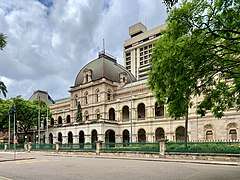
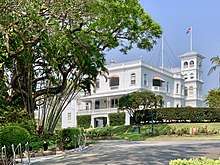
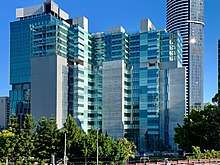
One of the six founding states of Australia, Queensland has been a federated state subject to the Australian Constitution since 1 January 1901. It is sovereign, other than in the matters ceded in the Australian Constitution to the federal government. It is a parliamentary constitutional monarchy. The Constitution of Queensland sets out the operation of the state's government. The state'a constitution contains several entrenched provisions which cannot be changed in the absence of a referendum. There is also a statutory bill of rights, the Queensland Human Rights Act (2019). Queensland's system of government is influenced by the Westminster system and Australia's federal system of government.
The government is separated into three branches:
- Legislature: the unicameral Parliament of Queensland, comprising the Legislative Assembly and the Monarch (represented by the Governor);
- Executive: the Executive Council of Queensland, which formalises decisions of the Cabinet of Queensland, which is composed of the Premier and other ministers of state appointed by the Governor on the advice of Parliament;
- Judiciary: the Supreme Court and other state courts, whose judges are appointed by the Governor on advice of Parliament.
Executive authority is nominally vested in the Governor of Queensland (currently Paul de Jersey) who represents and is appointed by the Monarch of Australia (currently Elizabeth II) on the advice of the Premier of Queensland. The Premier, who is the state's Head of government, along with the Cabinet of Queensland (whose decisions are formalised by the Executive Council), exercise executive authority in practice. The Premier is appointed by the Governor and must have support of the Legislative Assembly of Queensland. The Premier is in practice a leading member of the Legislative Assembly and parliamentary leader of his or her political party, or coalition of parties, and members of Cabinet will be drawn from the same party or coalition. The current Premier and Deputy Premier are Annastacia Palaszczuk and Steven Miles of the Labor Party respectively. Government House at Paddington in Brisbane is the seat of the Governor, having replaced Old Government House at Gardens Point in Brisbane's CBD in the early 20th century. The executive branch simply referred to as the Queensland Government.
Legislative authority is exercised by the Queensland Parliament which uniquely for Australian states is unicameral, containing only one house, the Legislative Assembly. The Parliament was bicameral until 1922, when the Legislative Council was abolished by the Labor "suicide squad", so called because they were appointed for the purpose of voting to abolish their own offices.[72] Bills receive royal assent from the Governor before being passed into law. The Parliament's seat is at Parliament House at Gardens Point in Brisbane's CBD. Members of the Legislative Assemby represent 93 electoral districts. Elections in Queensland are held at the end of each fixed four-year parliamentary term, and are determined by instant-runoff voting.
The state's judiciary consists of the Supreme Court of Queensland and the District Court of Queensland, established by the Queensland Constitution, as well as the Magistrates Court of Queensland and other courts and tribuals established by legislation. Cases may be appealed to the High Court of Australia. As with all Australian states and territories, Queensland has a Common law legal system. The Supreme and District courts are headquartered at the Queen Elizabeth II Courts of Law in Brisbane's CBD.
The state's politics are traditionally regarded as being conservative relative to other states.[73][74][75][76][77] Historically, the lack of an upper house, a former gerrymander favouring rural electoral districts as well as the former system of optional preferential voting has meant that Queensland had a long tradition of domination by strong-willed, populist premiers, often accused of authoritarian tendencies, holding office for long periods. This tendency was exemplified by the government of the state's longest-serving Premier Joh Bjelke-Petersen.
Local government
Local government is the mechanism by which local government areas can manage their own affairs to the extent permitted by the Local Government Act 2009. Queensland is divided into 77 local government areas, which are created by the state government under legislation.[78] Each local government area has a council responsible for providing a range of local services and utilities. Local councils derive their income from both rates and charges on resident ratepayers, and grants and subsidies from the state and federal governments.[79]
Federal representation
| Election | ||||||
|---|---|---|---|---|---|---|
| House of Representatives | Senate | |||||
| Coalition[N 7] | Labor | Other[N 8] | Coalition | Labor | Other | |
| 2001 | 19 | 7 | 1 | 5 | 4 | 3 |
| 2004 | 21 | 5 | 1 | 7 | 4 | 1 |
| 2007 | 13 | 15 | 1 | 7 | 5 | 0 |
| 2010 | 21 | 8 | 1 | 6 | 5 | 1 |
| 2013 | 22 | 6 | 2 | 6 | 4 | 2 |
| 2016 | 21 | 8 | 1 | 5 | 4 | 3 |
| 2019 | 23 | 6 | 1 | 6 | 3 | 3 |
In the federal Parliament of Australia, Queensland accounts for 30 of the 151 electoral divisions in the House of Representatives (on the basis of population size) and 12 of the 76 seats in the Senate (on the basis of equality between the states).
The current partisan makeup of Queensland's House of Representatives delegation is 23 Liberal National, 6 Labor and 1 Katter's Australian Party.
The current partisan makeup of Queensland's Senate delegation is 6 Liberal National, 3 Labor, 2 One Nation and 1 Green.
Culture
Queensland is home to major art galleries including the Queensland Art Gallery and the Queensland Gallery of Modern Art as well as cultural institutions such as the Queensland Ballet, Opera Queensland, Queensland Theatre Company, and Queensland Symphony Orchestra, all based at the Queensland Cultural Centre in Brisbane. The state is the origin of musicians such as the Bee Gees, The Go-Betweens, The Veronicas, The Saints, Savage Garden, and Sheppard as well as writers such as David Malouf, Nick Earls and Li Cunxin.
Major annual cultural events include the Royal Queensland Exhibition (known locally as the Ekka), an agricultural exhibition held each August at the Brisbane Showgrounds as well as the Brisbane Festival, which includes one of the nation's largest annual fireworks displays called 'Riverfire', and which is held each September.
Sport
The state of Queensland is represented in all of Australia's national sporting competitions and it is also host to a number of domestic and international sporting events. The most popular winter and summer team sports are Rugby league, Rugby union and cricket, respectively.
In the National Rugby League, the Brisbane Broncos, North Queensland Cowboys and Gold Coast Titans are based in the state. Rugby league's annual State of Origin series is a major event in the Queensland sporting calendar, with the Queensland Maroons representing the state.
The state is represented by the Queensland Reds in the Super Rugby (rugby union).
In cricket, the Queensland Bulls represent the state in the Sheffield Shield and the Ryobi One Day Cup, while the Brisbane Heat compete in the Big Bash League.
Queensland is also home to the Brisbane Lions and the Gold Coast Suns in the Australian Football League (Australian rules football), and the Brisbane Roar FC in the A-League (soccer). In netball the Queensland Firebirds went undefeated in the 2011 season as they went on to win the Grand Final. Other sports teams are the Brisbane Bullets and the Cairns Taipans, who compete in the National Basketball League.
Swimming is also a popular sport in Queensland, with many of Australian team members and international medalists hailing from the state.
Major sporting include hosted in Queensland:
- Gold Coast 600 (motorsport; since 1994)
- Gold Coast Marathon (athletics; since 1979)
- NRL All Stars Game (rugby league; since 2010)
- Townsville 400 (motorsport; since 2009)
- Quicksilver Pro and Roxy Pro (surfing)
- Australian PGA Championship (golf; since 2000)
Education
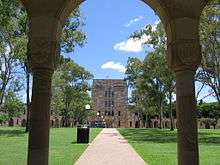
Queensland is home to numerous universities. The state's oldest university, the University of Queensland, was established in 1909 and frequently ranks among the world's top 50,[81][82][83]. Other major universities include Queensland University of Technology, Griffith University, the University of Southern Queensland, the University of the Sunshine Coast, James Cook University (which was the state's first university outside of South East Queensland), and Bond University (which was Australias' first private university).
International education is an important industry, with 134,312 international students enrolled in the state in 2018, largely focused on Brisbane. Most of the state's international students are from Asia.[63]
At the primary and secondary levels, Queensland is home to numerous state and private schools.
Infrastructure
Transport
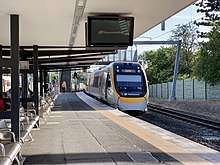
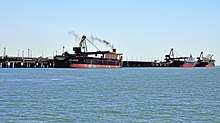
Queensland is served by a number of National Highways and, particularly in South East Queensland, a network of freeways such as the M1. The Department of Transport & Main Roads oversees the development and operation of main roads and public transport, including taxis and local aviation.
Principal rail services are provided by Queensland Rail and Pacific National, predominantly between the major centres east of the Great Dividing Range.
Major seaports include the Port of Brisbane, Australia's third busiest by value of goods, as well as those at Gladstone, Townsville and Bundaberg. There are large coal export facilities at Hay Point, Gladstone and Abbot Point. Major sugar export facilities are located at Lucinda and Mackay.
Brisbane Airport is the main international and domestic gateway serving the state, and is the third busiest in Australia. Other international airports include the Gold Coast Airport, Cairns International Airport and Townsville Airport. Regional airports with scheduled domestic flights include Toowoomba Wellcamp Airport, Great Barrier Reef Airport, Hervey Bay Airport, Bundaberg Airport, Mackay Airport, Mount Isa Airport, Proserpine / Whitsunday Coast Airport, Rockhampton Airport, and Sunshine Coast Airport.
South East Queensland has an integrated public transport system operated by TransLink, which provides services bus, rail, light rail and Brisbane's ferry services through Queensland Rail and contracted operators. The region is divided into seven fare zones radiating outwards from the Brisbane central business district, which is the central hub for the system. The Queensland Rail City network consists of 152 train stations along 13 suburban rail lines and across the region, and predominately within Brisbane's metropolitan area. There is also a large bus network including Brisbane's large dedicated bus rapid transit network, the Brisbane busway network. Brisbane's popular ferry services include the CityCat, CityFerry and CityHopper services which have dedicated wharves along the Brisbane River. The G:link, Queensland's only light rail network, operates on the Gold Coast.[84]
Other utilities
Queensland Health operates and administers the state's public health system. There are sixteen regional Health and Hospital Services corresponding to geographical regions which are responsible for delivering public health services within their regions. Major public hospitals include the Royal Brisbane and Women's Hospital, Princess Alexandra Hospital, the Mater Hospital, the Queen Elizabeth II Jubilee Hospital, and the Queensland Children's Hospital in Brisbane, as well as the Townsville University Hospital, Cairns Hospital, Cairns Hospital, Gold Coast Hospital and Gold Coast University Hospital in the regional cities. There are smaller public hospitals, as well as private hospitals, around the state.
Notes
- In the UK and US, /ˈkwiːnzlənd/ KWEENZ-lənd is the preferred variant.[4]
- Pre-1971 figures may not include the Indigenous population.
- In accordance with the Australian Bureau of Statistics source, England, Scotland, Mainland China and the Special Administrative Regions of Hong Kong and Macau are listed separately
- As a percentage of 4,348,289 persons who nominated their ancestry at the 2016 census.
- The Australian Bureau of Statistics has stated that most who nominate "Australian" as their ancestry are part of the Anglo-Celtic group.[58]
- Of any ancestry. Includes those identifying as Aboriginal Australians or Torres Strait Islanders. Indigenous identification is separate to the ancestry question on the Australian Census and persons identifying as Aboriginal or Torres Strait Islander may identify any ancestry.
- Of any ancestry. Includes those identifying as Aboriginal Australians or Torres Strait Islanders. Indigenous identification is separate to the ancestry question on the Australian Census and persons identifying as Aboriginal or Torres Strait Islander may identify any ancestry.
- Includes the Liberal Party of Australia, National Party of Australia, Liberal National Party of Queensland and Country Liberal Party. In 2008, all Coalition parties in Queensland merged into the Liberal National Party of Queensland.
- Includes independents and minor parties.
References
- "Australian Demographic Statistics, Dec 2019". 18 June 2020. Retrieved 18 June 2020. Estimated Resident Population – 31 December 2019
- "5220.0 – Australian National Accounts: State Accounts, 2018–19". Australian Bureau of Statistics. 15 November 2019. Archived from the original on 20 April 2020. Retrieved 20 November 2019.
- "Floral Emblem of Queensland". Australian National Botanic Gardens. Archived from the original on 8 March 2012. Retrieved 23 January 2013.
- Wells, John C. (2008), Longman Pronunciation Dictionary (3rd ed.), Longman, ISBN 9781405881180
- "Archived copy". Archived from the original on 13 April 2020. Retrieved 28 May 2020.CS1 maint: archived copy as title (link)
- "Archived copy". Australian Bureau of Statistics. Archived from the original on 22 June 2019. Retrieved 28 May 2020.CS1 maint: archived copy as title (link)
- "2016 Census of Population and Housing: General Community Profile" (ZIP). Australian Bureau of Statistics. Retrieved 31 May 2020.
- "How Old is Australia's Rock Art?". Aboriginal Art Online. Archived from the original on 4 May 2013. Retrieved 15 May 2013.
- Dortch, C.E.; Hesp, P.A. (1994). "Rottnest Island artifacts and palaeosols in the context of Greater Swan Region prehistory". Journal of the Royal Society of Western Australia. 77: 23–32.
- "Pomona – Quinalow". Place Names of South East Queensland. Archived from the original on 13 October 2007. Retrieved 13 October 2007.
- Karl Bitar. "Labor History: Timeline: Foundations: Colonial Origins". Archived from the original on 27 November 2012. Retrieved 24 August 2010.
- "National Museum of Australia – Richard Daintree's glass plates". Archived from the original on 17 March 2011.
- A History of Queensland by Raymond Evans, Cambridge University Press, 2007 ISBN 978-0-521-87692-6
- "European discovery and the colonisation of Australia". culture.gov.au. Archived from the original on 16 February 2011. Retrieved 24 February 2014.
- Cumpston, JHL (1914). The History of Small-Pox in Australia 1788–1908. Melbourne: Australian Government Printer.
- Fenner, F.; Henderson, D.A.; Arita, I.; Jezek, Z. & Ladnyi, I.D. (1988). Smallpox and Its Eradication (History of International Public Health, No. 6) (PDF). Geneva: World Health Organization. ISBN 978-92-4-156110-5. Archived (PDF) from the original on 27 September 2007.
- Campbell, Judy; 2002, Invisible Invaders: Smallpox and Other Diseases in Aboriginal Australia 1780–1880, Carlton, Melbourne University Press, pp60–2, 80–1, 194–6, 201, 216–7
- Willis, H.A. (2011). "Bringing Smallpox with the First Fleet". Quadrant. 55 (7–8): 2. ISSN 0033-5002.
- "New Hope Group". Archived from the original on 27 February 2014. Retrieved 25 February 2014.
- "Extermination of the Queenslands Blacks". Empire (5246). New South Wales, Australia. 12 September 1868. p. 3. Retrieved 12 September 2017 – via National Library of Australia.
- "Welcome to Frontier". Abc.net.au. Archived from the original on 18 July 2006. Retrieved 4 August 2010.
- Australia. "Stories of the Dreaming – Australian Museum". Dreamtime.net.au. Archived from the original on 8 February 2009. Retrieved 4 August 2010.
- NSWV&P re 26 October 1857
- MBC 14 November 1857
- Book: Reid, Gordon: A Nest of Hornets: The Massacre of the Fraser family at Hornet Bank Station, Central Queensland, 1857, and related events, Melbourne 1982.
- "The Massacre by the Blacks at Nogoa". The Maitland Mercury And Hunter River General Advertiser. XVIII (2106). New South Wales, Australia. 19 November 1861. p. 2. Retrieved 12 September 2017 – via National Library of Australia.
- R Evans, quoted in T Bottoms (2013) Conspiracy of Silence: Queensland's frontier killing times, Allen & Unwin, p.181
- "Q150 Timeline". Queensland Treasury. Archived from the original on 3 September 2011. Retrieved 28 October 2011.
- Rickard, John (2017). Australia: A Cultural History. p. 173. ISBN 978-1-921867-60-6.
- "Documenting Democracy". Foundingdocs.gov.au. Archived from the original on 26 October 2009. Retrieved 4 August 2010.
- "Queensland Registry of Births, Deaths and Marriages World War One commemorative death certificates | Queensland's World War 1 Centenary". blogs.slq.qld.gov.au. Archived from the original on 3 February 2016. Retrieved 20 January 2016.
- Peter Dunn (2 March 2005). "Hirings Section". Australia @ War. Archived from the original on 12 October 2007. Retrieved 7 January 2008.
- Peter Dunn (27 August 2005). "The Battle of Brisbane — 26 & 27 November 1942". Australia @ War. Archived from the original on 10 January 2008. Retrieved 7 January 2008.
- Lowe, Ian (2012). Bigger Or Better?: Australia's Population Debate. University of Queensland Press. ISBN 9780702248078.
- Berry, Petrina (13 January 2011). "Brisbane braces for flood peak as Queensland's flood crisis continues". The Courier-Mail. Archived from the original on 16 August 2011. Retrieved 14 January 2011.
- "Before and after photos of the floods in Brisbane". Abc.net.au. Archived from the original on 12 July 2011. Retrieved 4 November 2012.
- National Climate Centre. "Australian Government, Bureau of Meteorology – Climate of Queensland". Bureau of Meteorology. Archived from the original on 17 March 2009. Retrieved 4 August 2010.
- "Australian Government, Bureau of Meteorology – Australian climatic zones". Bom.gov.au. Retrieved 4 August 2010.
- "Australian Government, Bureau of Meteorology – Climate statistics for Australian locations". Bureau of Meteorology. 19 July 2010. Archived from the original on 24 February 2011. Retrieved 4 August 2010.
- "Brisbane Regional Office". Climate statistics for Australian locations. Bureau of Meteorology. Retrieved 26 September 2010.
- "Mackay M.O." Climate statistics for Australian locations. Bureau of Meteorology. Retrieved 26 September 2010.
- "Cairns Aero". Climate statistics for Australian locations. Bureau of Meteorology. Retrieved 20 October 2018.
- "Townsville Aero". Climate statistics for Australian locations. Bureau of Meteorology. Retrieved 26 September 2010.
- "Rainfall and Temperature Records". Climate Extremes. Bureau of Meteorology. 28 February 2013. Archived from the original on 13 March 2014. Retrieved 26 March 2014.
- "Queensland Snow Events". Weather Armidale. Archived from the original on 10 December 2013. Retrieved 16 May 2014.
- "Queensland Cyclones". Emergency Management Queensland. Archived from the original on 28 May 2014. Retrieved 4 June 2014.
- "Queensland Floods Summary". Bureau of Meteorology. Archived from the original on 6 June 2014. Retrieved 4 June 2014.
- "Queensland Severe Storms". Emergency Management Queensland. Archived from the original on 10 July 2014. Retrieved 4 June 2014.
- "Tornadoes". Bureau of Meteorology. Archived from the original on 17 March 2009. Retrieved 6 April 2008.
- "Rainfall and Temperature Records". Bureau of Meteorology (Australian Government). Archived from the original on 4 June 2013. Retrieved 13 June 2013.
- "Rainfall and Temperature Records: National" (PDF). Bureau of Meteorology. Archived (PDF) from the original on 10 November 2010. Retrieved 14 November 2009.
- "Official records for Queensland in February". Daily Extremes. Bureau of Meteorology. 30 June 2017. Archived from the original on 12 March 2018. Retrieved 8 July 2017.
- "Official records for Queensland in October". Daily Extremes. Bureau of Meteorology. 30 June 2017. Archived from the original on 12 March 2018. Retrieved 8 July 2017.
- "Historical tables, demography, 1823 to 2008 (Q150 release)". Queensland Government Statistician's Office. Archived from the original on 16 June 2019. Retrieved 22 June 2019.
- "Archived copy". Archived from the original on 1 April 2019. Retrieved 22 June 2019.CS1 maint: archived copy as title (link)
- "Archived copy". Australian Bureau of Statistics. Archived from the original on 23 February 2020. Retrieved 28 May 2020.CS1 maint: archived copy as title (link)
- "Archived copy". Archived from the original on 18 July 2019. Retrieved 28 May 2020.CS1 maint: archived copy as title (link)
- "Feature Article - Ethnic and Cultural Diversity in Australia (Feature Article)". Australian Bureau of Statistics. Archived from the original on 20 April 2016. Retrieved 28 May 2020.
- "Media Release - 2016 Census: Queensland". Australian Bureau of Statistics. 27 June 2017. Retrieved 1 April 2020.
- "Archived copy". Archived from the original on 20 April 2020. Retrieved 28 May 2020.CS1 maint: archived copy as title (link)
- Tom Dusevic (17 December 2009). "Queensland falls back with the pack". The Australian. Archived from the original on 29 January 2012. Retrieved 10 January 2010.
- "Gladstone". Comalco.com. Rio Tinto Aluminium. Archived from the original on 17 August 2009. Retrieved 9 March 2016.
- "International students studying in regional areas" (PDF). February 2019. Archived (PDF) from the original on 9 March 2019. Retrieved 28 May 2020.
- "Brisbane business visitor numbers skyrocket". Brisbane Marketing Convention Bureau. e-Travel Blackboard. 3 January 2008. Archived from the original on 20 January 2011. Retrieved 13 January 2008.
- "Brisbane Top Companies". Business News Australia. 11 October 2019. Archived from the original on 23 April 2020. Retrieved 19 April 2020.
- "About TQ – Profile". Tourism Queensland. Archived from the original on 14 September 2009. Retrieved 6 January 2010.
- "Tourism related information and statistics". Discoverqueensland.com.au. Archived from the original on 20 February 2011. Retrieved 4 August 2010.
- "The Great Barrier Reef and beyond: a beginner's guide to Queensland's coast". Lonely Planet. 1 September 2015. Archived from the original on 21 October 2016. Retrieved 20 October 2016.
- Kristof Haines (19 August 2015). "Earth's Top Travel Destinations Revealed". Writer for AirportRentals.com. AirportRentals.com. Archived from the original on 21 October 2016. Retrieved 20 October 2016.
- TravelTreks (8 September 2016). "Australia's Top 50 Small Towns". www.DiscountMyFlights.com.au. Stapylton, Queensland, Australia. Archived from the original on 27 October 2016. Retrieved 20 October 2016.
- "International Market Tourism Facts" (PDF). Tourism Australia. Archived from the original (PDF) on 7 March 2008.
- Wanna, John (2003). "Queensland". In Moon, Campbell; Sharman, Jeremy (eds.). Australian Politics and Government: The Commonwealth, the States and Territories. Cambridge, United Kingdom: Cambridge University Press. p. 47. ISBN 978-0-521-82507-8. Archived from the original on 2 January 2016. Retrieved 15 November 2011.
- Daly, Margo (2003). The Rough Guide To Australia. Rough Guides Ltd. p. 397. ISBN 978-1-84353-090-9.
- Penrith, Deborah (2008). Live & Work in Australia. Crimson Publishing. p. 478. ISBN 978-1-85458-418-2.
- "Why Labor struggles in Queensland". 23 August 2010. Archived from the original on 15 January 2013.
- George Megalogenis, "The Green and the Grey", Quarterly Essay, Vol. 40, 2010, p69.
- "Australia ready for first female leader". BBC News. 25 June 2010. Archived from the original on 25 April 2012.
- Local Government Act 1993 Archived 23 April 2011 at the Wayback Machine, s.34. (Reprint 11E, as in force at 22 November 2007.)
- "Rates and valuations". Queensland: Department of Local Government, Sport and Recreation. 26 July 2007. Archived from the original on 19 March 2008. Retrieved 5 April 2008.
- "Historical information on the Australian Parliament". Parliament of Australia. Archived from the original on 25 May 2019. Retrieved 24 May 2020.
- "Archived copy". Archived from the original on 17 September 2012. Retrieved 28 May 2020.CS1 maint: archived copy as title (link)
- "Archived copy". Archived from the original on 28 October 2014. Retrieved 28 May 2020.CS1 maint: archived copy as title (link)
- "Archived copy". Archived from the original on 23 December 2017. Retrieved 28 May 2020.CS1 maint: archived copy as title (link)
- "Sharing the road with trams | Transport and motoring". Department of Transport and Main Roads. Queensland Government. Archived from the original on 9 November 2017. Retrieved 8 November 2017.
External links
| Wikimedia Commons has media related to Queensland. |
| Wikivoyage has a travel guide for Queensland. |

- Government of Queensland
- State Archives, Government of Queensland
- State Library, Government of Queensland
- Far North Queensland (historical footage), AU: National Film and Sound Archive, 21 August 2012.
- Daintrees, Richard, Glass plates, AU: National Museum.
- Works by Queensland at Project Gutenberg
- Works by or about Queensland at Internet Archive
